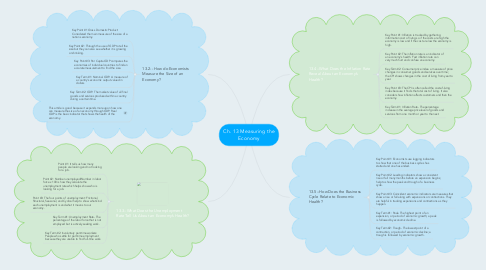Ch. 13 Measuring the Economy
by Emily Dorsey

1. 13.2-- How do Economists Measure the Size of an Economy?
1.1. Key Point #1 Gross Domestic Product: Considered the main measure of the size of a nations economy.
1.2. Key Point #2: Through the use of GDP to tell the size but they can also see whether it is growing or shrinking.
1.3. Key Point #3: Per Capita GDP compares the economies of individual countries to find an accurate measurement to find the size.
1.4. Key Term #1: Nominal GDP- A measure of a country's economic output valued in dollars
1.5. Key Term #2: GDP- The market value of all final goods and services produced within a country during a certain time.
1.6. This article is good because it expands more upon how one can measure the size of an economy through GDP. Real GDP is the basic indicator that shows the health of the economy.
2. 13.3--What Does the Unemployment Rate Tell Us About an Economy’s Health?
2.1. Point #1: It tells us how many people are looking and not looking for a job.
2.2. Point #2: Number unemployed/Number in labor force x 100 is how they calculate the unemployment rate which helps show who is looking for a job.
2.3. Point #3: The four points of unemployment: Frictional, Structural, Seasonal, and Cyclical help to show what kind each unemployment is and what it means to our economy.
2.4. Key Term #1: Unemployment Rate- The percentage of the labor force that is not employed but is actively seeking work.
2.5. Key Term #2: Involuntary part-time workers: People who settle for part-time employment because they are unable to find full-time work.
3. 13.4--What Does the Inflation Rate Reveal About an Economy’s Health?
3.1. Key Point #1: Inflation is tracked by gathering information cost of living so if the costs are high the economy is low and if the cost are low the economy is high.
3.2. Key Point #2: The inflation rate is an indicator of an economy's health. Fast inflation rate can very much hurt and confuse an economy.
3.3. Key Term #2: Consumer price index- a measure of price changes in consumer goods and services over time; the CPI shows changes in the cost of living from year to year.
3.4. Key Point #3: The CPI is often called the cost-of-living index because it finds the total cost of living. It also considers how inflation affects customers and then the economy.
3.5. Key Term #1: Inflation Rate- The percentage increase in the average price level of goods and services from one month or year to the next.
4. 13.5--How Does the Business Cycle Relate to Economic Health?
4.1. Key Point #1: Economists use lagging indicators to show that one of the business cycles has started and one has ended.
4.2. Key Point #2: Leading indicators show a consistent rise or fall many months before an expansion begins; help to show the peak and trough of a business cycle.
4.3. Key Point #3: Coincident economic indicators are measures that show a rise or fall along with expansions or contractions. They are helpful in tracking expansions and contractions as they happen.
4.4. Key Term #1: Peak- The highest point of an expansion, or period of economic growth; a peak is followed by economic decline.
4.5. Key Term #2: Trough- The lowest point of a contraction, or period of economic decline; a trough is followed by economic growth.


